Acura Integra 2000 Sedan Owner's Manual
Manufacturer: ACURA, Model Year: 2000, Model line: Integra, Model: Acura Integra 2000Pages: 273, PDF Size: 4.4 MB
Page 221 of 273

218
Page 222 of 273
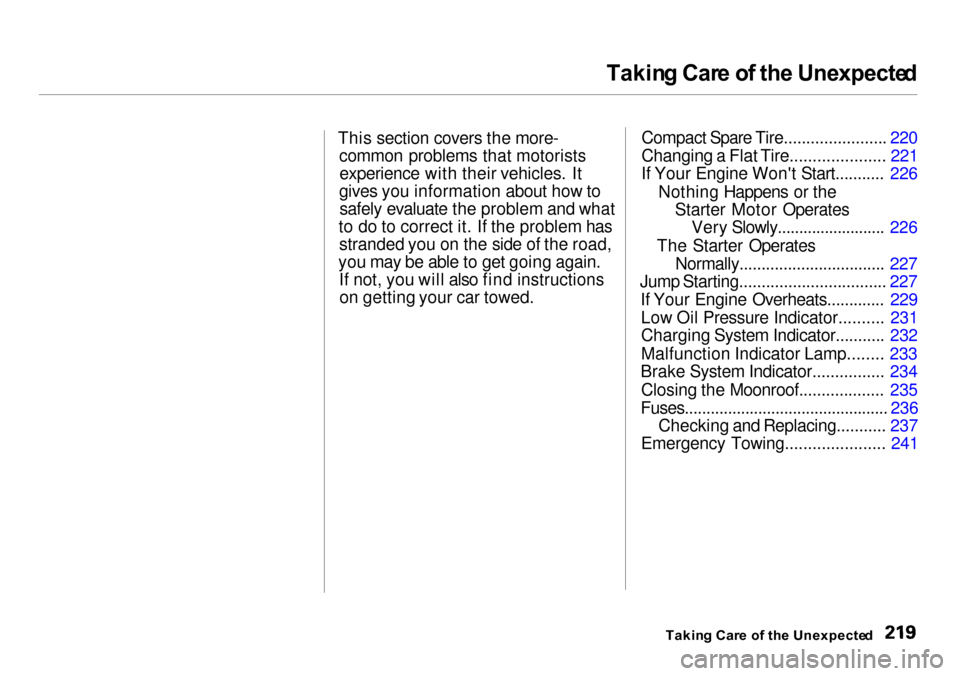
Takin
g Car e o f th e Unexpecte d
This section covers the more- common problems that motoristsexperience with their vehicles. It
gives you information about how to safely evaluate the problem and what
to do to correct it. If the problem has stranded you on the side of the road,
you may be able to get going again. If not, you will also find instructionson getting your car towed. Compact Spare Tire....................... 220
Changing a Flat Tire..................... 221
If Your Engine Won't Start........... 226
Nothing Happens or theStarter Motor OperatesVery Slowly......................... 226
The Starter Operates Normally................................. 227
Jump Starting................................. 227
If Your Engine Overheats............. 229Low Oil Pressure Indicator.......... 231
Charging System Indicator........... 232
Malfunction Indicator Lamp........ 233
Brake System Indicator................ 234
Closing the Moonroof................... 235
Fuses............................................... 236 Checking and Replacing........... 237
Emergency Towing...................... 241
Takin g Car e o f th e Unexpecte d
Page 223 of 273
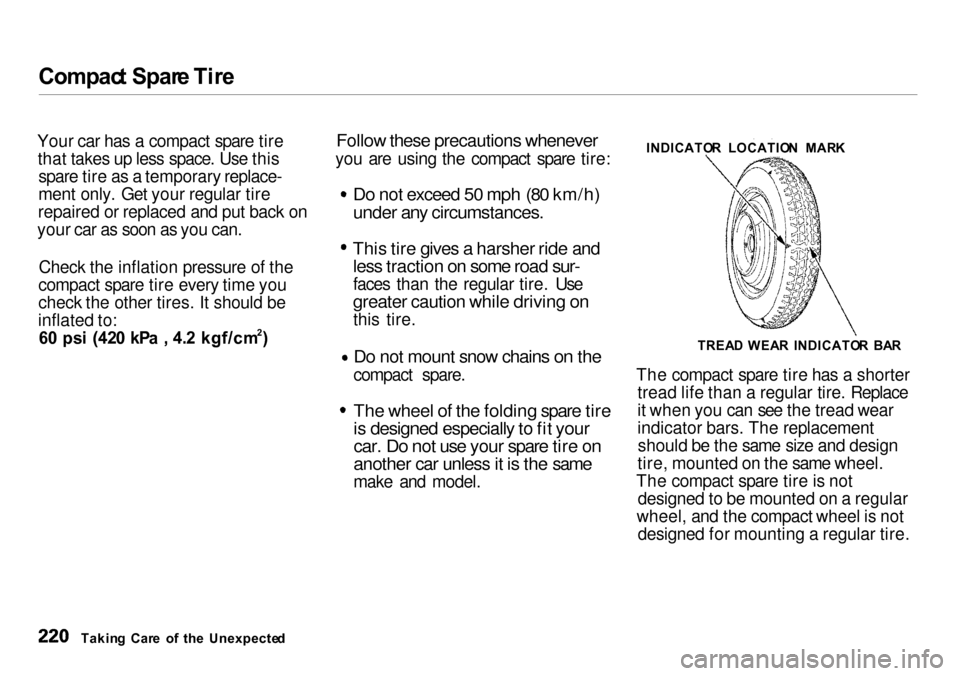
Compac
t Spar e Tir e
Your car has a compact spare tire that takes up less space. Use this spare tire as a temporary replace-
ment only. Get your regular tire
repaired or replaced and put back on
your car as soon as you can.
Check the inflation pressure of the
compact spare tire every time you
check the other tires. It should be
inflated to:6 0 ps i (42 0 kP a , 4. 2 kgf/cm 2
)
Follow thes
e precautions whenever
you are using the compact spare tire:
Do not exceed 50 mph (80 km/h)
under any circumstances.
This tire gives a harsher ride and
less traction on some road sur-
faces than the regular tire. Use
greater caution while driving on
this tire.
Do not mount snow chains on the
compact spare.
The wheel of the folding spare tire
is designed especially to fit your
car. Do not use your spare tire on
another car unless it is the same
make and model.
The compact spare tire has a shorter
tread life than a regular tire. Replace
it when you can see the tread wear
indicator bars. The replacementshould be the same size and design
tire, mounted on the same wheel.
The compact spare tire is not designed to be mounted on a regular
wheel, and the compact wheel is not designed for mounting a regular tire.
Takin g Car e o f th e Unexpecte d INDICATO
R LOCATIO N MAR K
TREA D WEA R INDICATO R BA R
Page 224 of 273
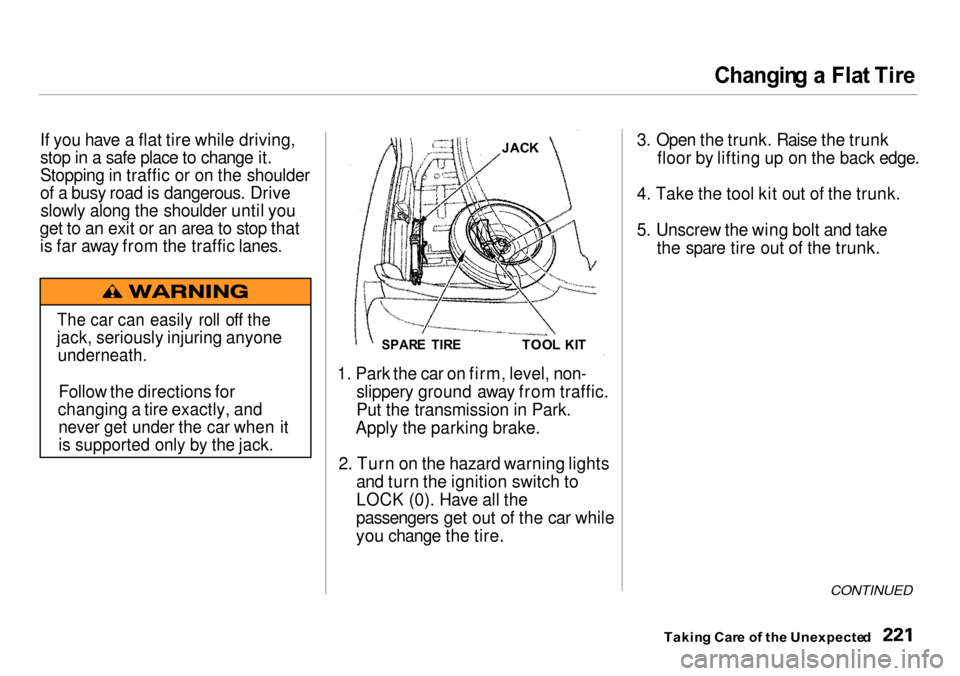
Changin
g a Fla t Tir e
If you have a flat tire while driving,
stop in a safe place to change it.
Stopping in traffic or on the shoulder
of a busy road is dangerous. Drive slowly along the shoulder until you
get to an exit or an area to stop that is far away from the traffic lanes.
1. Park the car on firm, level, non-slippery ground away from traffic.
Put the transmission in Park.
Apply the parking brake.
2. Turn on the hazard warning lights and turn the ignition switch to
LOCK (0). Have all the
passengers get out of the car while
you change the tire. 3. Open the trunk. Raise the trunk
floor by lifting up on the back edge.
4. Take the tool kit out of the trunk.
5. Unscrew the wing bolt and take the spare tire out of the trunk.
CONTINUED
Takin g Car e o f th e Unexpecte d
TOO
L KI T
SPAR E TIR E
JAC
K
The car can easily roll off the
jack, seriously injuring anyone
underneath.
Follow the directions for
changing a tire exactly, and
never get under the car when it
is supported only by the jack.
Page 225 of 273
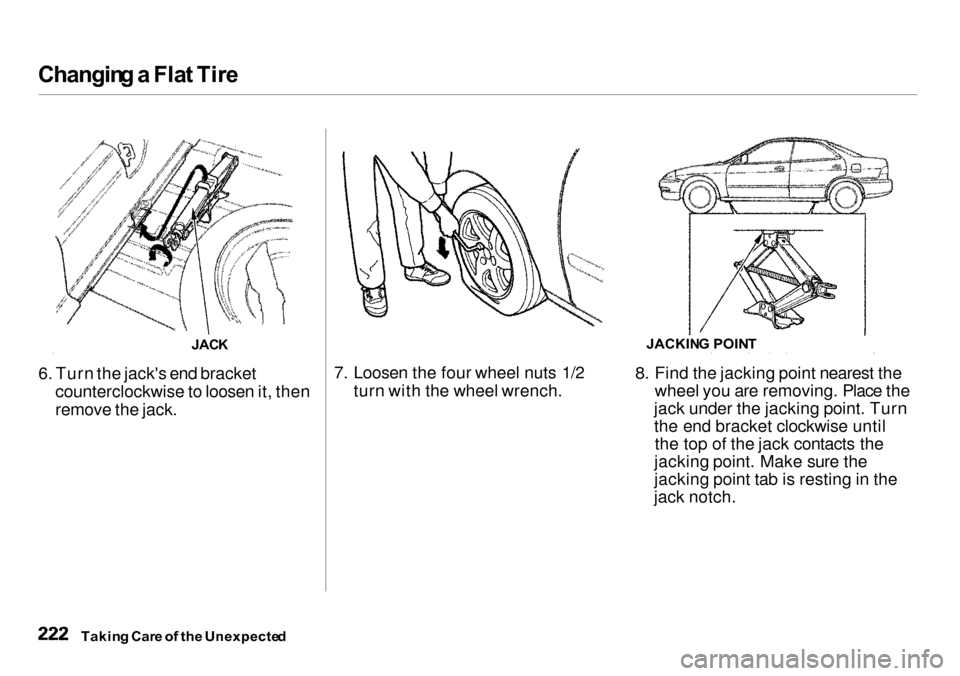
Changin
g a Fla t Tir e
6. Turn the jack's end bracket counterclockwise to loosen it, then
remove the jack. 7. Loosen the four wheel nuts 1/2
turn with the wheel wrench. 8. Find the jacking point nearest the
wheel you are removing. Place the
jack under the jacking point. Turn the end bracket clockwise until the top of the jack contacts the
jacking point. Make sure the
jacking point tab is resting in the
jack notch.
Takin g Car e o f th e Unexpecte d JACKIN
G POIN T
JAC K
Page 226 of 273
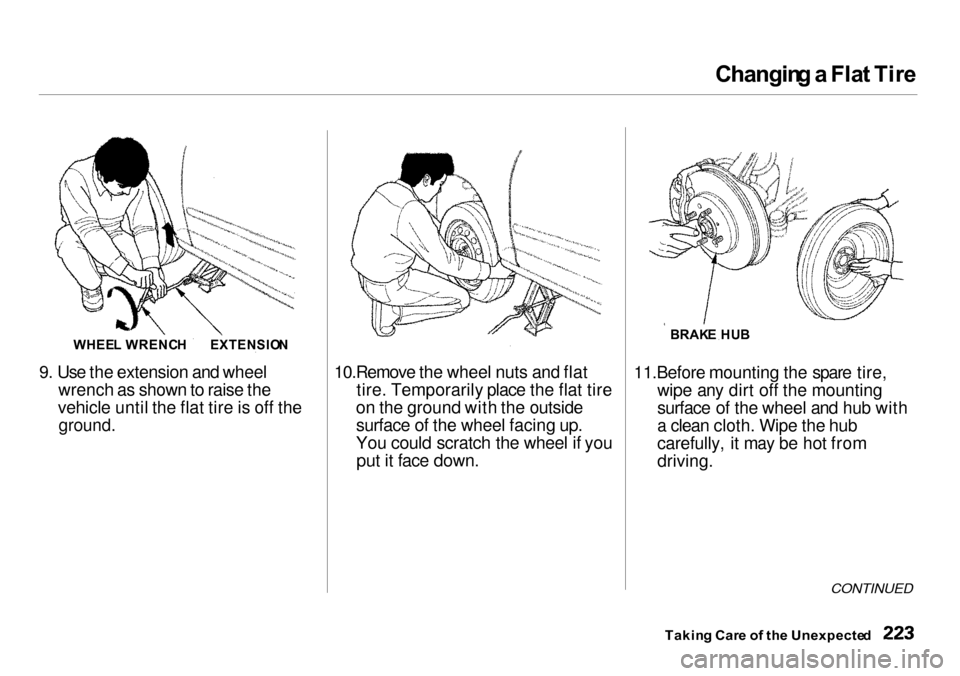
Changin
g a Fla t Tir e
9. Use the extension and wheel wrench as shown to raise the
vehicle until the flat tire is off the
ground.
10.Remove the wheel nuts and flat
tire. Temporarily place the flat tire
on the ground with the outside
surface of the wheel facing up.
You could scratch the wheel if you put it face down. 11.Before mounting the spare tire,
wipe any dirt off the mounting
surface of the wheel and hub with
a clean cloth. Wipe the hub
carefully, it may be hot from
driving.
CONTINUED
Takin g Car e o f th e Unexpecte d
EXTENSIO
N
WHEE L WRENC H BRAK
E HU B
Page 227 of 273

Changin
g a Fla t Tir e
12.Put on the spare tire. Put the wheel nuts back on finger-tight,then tighten them in a crisscross
pattern with the wheel wrench
until the wheel is firmly against
the hub. Do not try to tighten
them fully. 13.Lower the car to the ground and
remove the jack.
14.Tighten the wheel nuts securely in
the same crisscross pattern. Have
the wheel nut torque checked at
the nearest automotive service
facility.
Tighten the wheel nuts to:
80 Ibf .
ft (108 N .
m , 11 kgf .
m)
Takin g Car e o f th e Unexpecte d
Page 228 of 273
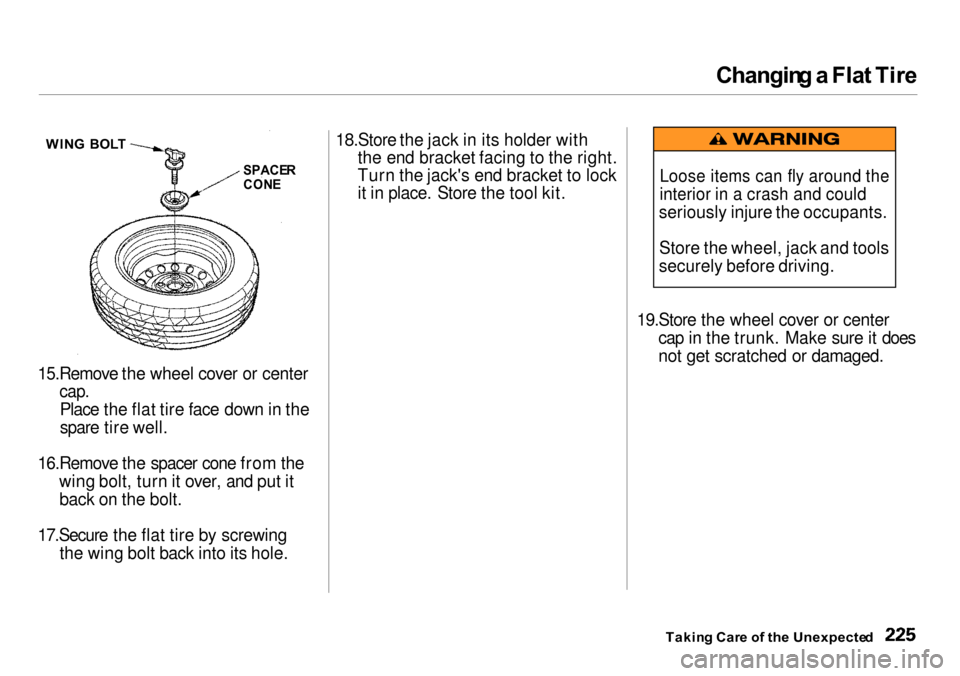
Changin
g a Fla t Tir e
15.Remove the wheel cover or center
cap.
Place the flat tire face down in the
spare tire well.
16.Remove the spacer cone from the wing bolt, turn it over, and put itback on the bolt.
17.Secure the flat tire by screwing the wing bolt back into its hole. 18.Store the jack in its holder with
the end bracket facing to the right.
Turn the jack's end bracket to lock
it in place. Store the tool kit.
19.Store the wheel cover or centercap in the trunk. Make sure it does
not get scratched or damaged.
Takin g Car e o f th e Unexpecte d
SPACE
R
CON E
WIN
G BOL T
Loose items can fly around the
interior in a crash and could
seriously injure the occupants.
Store the wheel, jack and tools
securely before driving.
Page 229 of 273

I
f You r Engin e Won' t Star t
Diagnosing why your engine won't start falls into two areas, depending
on what you hear when you turn the
key to START (III): You hear nothing, or almost
nothing. The engine's starter
motor does not operate at all, or
operates very slowly. You can hear the starter motor
operating normally, or the starter
motor sounds like it is spinning faster than normal, but the engine
does not start up and run.
Nothin g Happen s o r th e Starte r
Moto r Operate s Ver y Slowl y
When you turn the ignition switch to
START (III), you do not hear the
normal noise of the engine trying to start. You may hear a clicking sound
or series of clicks, or nothing at all.
Check these things: Your car has the Immobilizer
System. You should use a
properly-coded master or valet key
to start the engine (see page 69 ).
A key that is not properly coded will cause the immobilizer system indicator in the dash panel to blink
rapidly. Check the transmission interlock.
If you have a manual transmission,
the clutch pedal must be pushed all the way to the floor or thestarter will not operate. With an
automatic transmission, it must be in Park or Neutral. Turn the ignition switch to ON (II).
Turn on the headlights and check
their brightness. If the headlightsare very dun or don't light at all,
the battery is discharged. See
Jum p Startin g on page 227. Turn the ignition switch to START
(III). If the headlights do not dim, check the condition of the fuses. If
the fuses are OK, there is proba-
bly something wrong with the electrical circuit for the ignitionswitch or starter motor. You will
need a qualified technician to determine the problem. (See
Emergenc y Towin g on page 241 .)
If the headlights dim noticeably or
go out when you try to start the engine, either the battery is dis-
charged or the connections are corroded. Check the condition of
the battery and terminal connec-
tions (see page 186 ). You can
then try jump starting the car from a booster battery (see page 227 ).
Takin g Car e o f th e Unexpecte d
Page 230 of 273

I
f You r Engin e Won' t Start , Jum p Startin g
Th e Starte r Operate s Normall y
In this case, the starter motor's speed sounds normal, or even faster
than normal, when you turn the ignition switch to START (III), but
the engine does not run. Are you using the proper starting
procedure? Refer to Startin g th e
Engin e on page 133 . Do you have fuel? Turn the
ignition switch to ON (II) for a
minute and watch the fuel gauge.
The low fuel level warning light may not be working, so you were
not reminded to fill the tank. There may be an electrical
problem, such as no power to the
fuel pump. Check all the fuses (see page 237).
If you find nothing wrong, you will
need a qualified technician to find
the problem. See Emergenc y
Towin g on page 241. Jum
p Startin g
If your car's battery has run down,
you may be able to start the engine
by using a booster battery. Although this seems like a simple procedure,
you should take several precautions.
You cannot start an Acura with an automatic transmission by pushing
or pulling it. To jump start your car, follow these
directions closely:
1. Open the hood and check the physical condition of the battery
(see page 187). In very cold weather, check the condition of the electrolyte. If it seems slushyor like ice, do not try jump starting
until it thaws.
If a battery sits in extreme cold, the
electrolyte inside can freeze.
Attempting to jump start with a frozen
battery can cause it to rupture.
2. Turn off all the electrical acces- sories: heater, A/C, stereo system,
lights, etc.
Put the transmission in Neutral or
Park and set the parking brake.
CONTINUED
Takin g Car e o f th e Unexpecte d
A battery can explode if you do
not follow the correct procedure,
seriously injuring anyone
nearby.
Keep all sparks, open flames,
and smoking materials away
from the battery.
NOTIC
E